Energy Master Plans at Community Level | Smart Electrical Grid | Integrated Networks for Heating and Cooling | Community Resilience | Acute Need for Professionals | Smart City - Challenges and Approach to Address Them | Smart Community Solution | Hybrid Work
Energy Master Plans at Community Level
Efforts to decarbonize the planet are leading to the enhanced electrification of buildings and infrastructure through the integration of buildings, distributed energy resources (renewables) and charging of electric cars in a so-called “Connected Community” (CC), which is defined as: a group of grid-interactive efficient buildings (GEB) with diverse, flexible end-use equipment and other distributed energy resources that collectively work to maximize building, community and grid efficiency – all linked via a smart grid. Thermal networks are also optimizing energy use in connected communities.
ASHRAE is in a leadership position to drive the integration across many different organizations including the U.S. Department of Energy's Office of Energy Efficiency and Renewable Energy (EERE), DOE’s Office of Electricity, and Lawrence Berkeley National Laboratory, to bring together critical technologies and programs. Complementing this, ASHRAE can bring in the perspective of the end users and consumers.
Decarbonizing the planet to avoid catastrophic climate change requires the electrification of buildings and infrastructure. This is best done through the digital integration of buildings and distributed renewable energy and transport - resulting in a “Connected Community,” which the Department of Energy (DoE) defines as: “a group of grid-interactive efficient buildings (GEB) with diverse, flexible end-use equipment and other distributed energy resources that collectively work to maximize building, community and grid efficiency – all linked via a smart grid.”
Smart Electrical Grid
A smart grid is a key element of a connected community. It is a platform that links the numerous sources of supply with demand, and which automates their participation by interpreting their data and allowing bidirectional communication between the grid generators (i.e. power stations and distributed energy sources and end users, such as housing, industry, commerce, electrical vehicles (EVs) and so on.
Distributed Energy Resources (DER) are defined by the Department of Energy (DOE) as: “a resource (at the community-or building-scale) that can provide all or some immediate electric and/or power needs and can also be used by the community to either reduce demand (for example, through energy efficiency) or supply power to satisfy the energy, capacity, or ancillary service needs of the distribution grid.”
Examples of DERs are: photovoltaics (PV), energy storage, wind, combined heat and power (CHP), demand response (DR), energy efficiency (EE), microgrids, and electric vehicle charging infrastructure. DERs increase the supply capacity and reduce the demand.
Smart Grid:
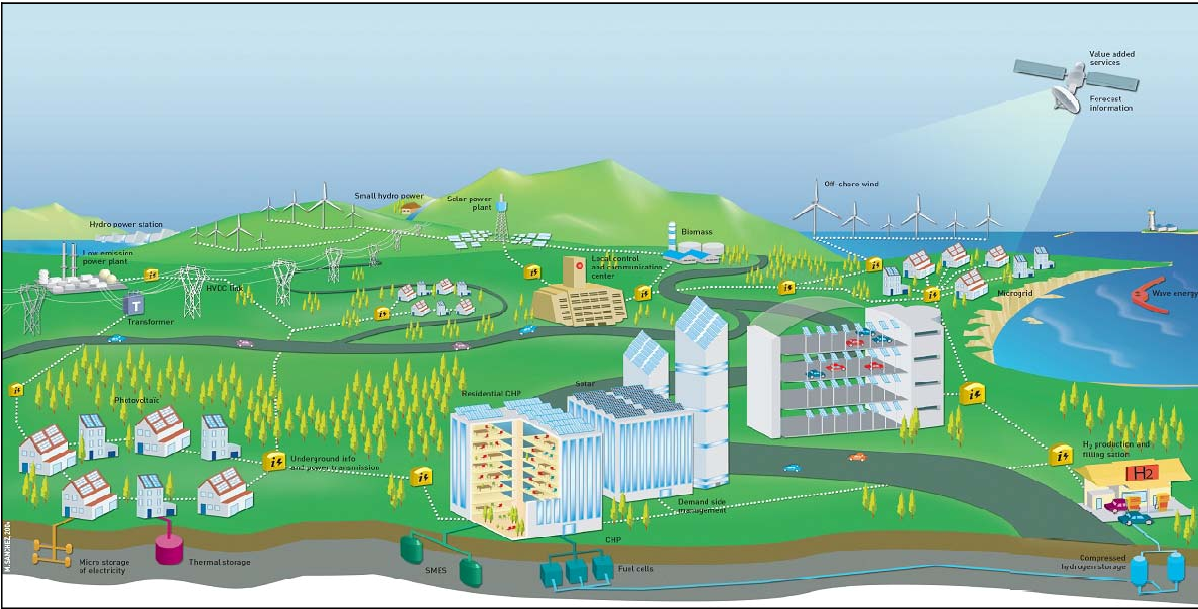
(Source: TP Smart Grids Green Net-Incentives EIE / 06 / 217 / SI 2 . 445571)
|
Grid-Interactive Efficient Commercial Buildings:
Buildings – both commercial and residential that participate in the smart grid, must be interactive and efficient. The ability of energy-efficient groups of buildings and DERs to modify the load, reduces energy demand and environmental impact.
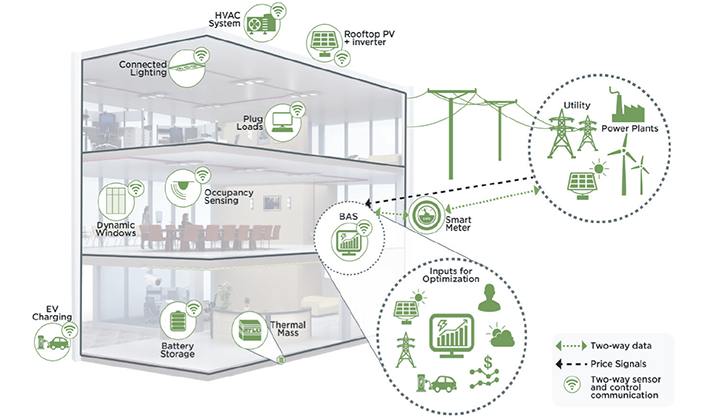
(Source: US. Department of Energy, Office of Energy Efficiency & Renewable Resources)
|
Integrated Networks for Heating and Cooling:
In northern latitudes, heating demand can exceed electrical demand for cooling, lighting and plug load. Integrated networks offer the possibility of efficient district energy and combined heat and power systems that can distribute thermal energy to multiple buildings in an area or neighborhood. They typically consist of a heating and cooling center, and a thermal network of pipes connecting a group of buildings. These systems are most effective in high-density cities (where half of the world population lives). In some cases, there may be a synergy in which one type of building transfers its excess heat into the system, which is used to meet the heating demand another different sort of building.
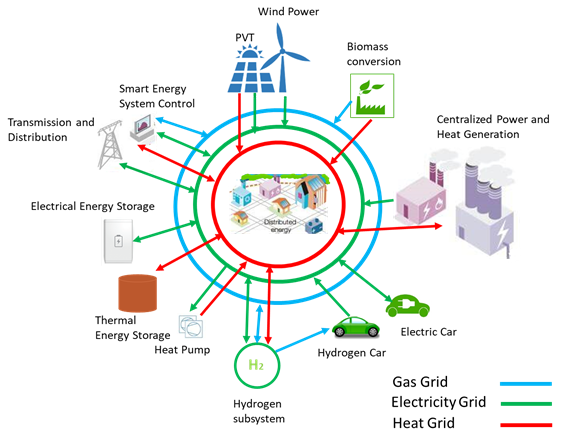
(Source: Energy Integration https://www.utwente.nl/en/et/tfe/research-groups/TE/research/research/Energy_Systems_Integration/)
|
Integrated Networks - Energy exchange:
Integrated Networks also enable the use of less carbon-intensive fuel sources such as hydrogen, biogas, ground heat, solar thermal heat, waste heat from sewers and cold water for cooling. Both smart electrical grid and low-carbon energy networks can be well-integrated with connected buildings.

(Source: REAP (Rotterdam Energy Approach and Planning), Credit: Eric Verdult (Kennis in Beeld), based on information and research from Andy van den Dobbelsteen on the Rotterdam Energy Approach & Planning (REAP) [Tillie et al. 2009] )
|
Community Resilience:
Community resilience is defined by a community's ability to use available resources to respond to, withstand, and recover from adverse situations. A Connected Community solution such as Distributed Generation and Combined Heat and Power will strengthen community resilience and help people, businesses, and cities maintain essential functions and bounce back from adversity as well as enhance wellbeing.
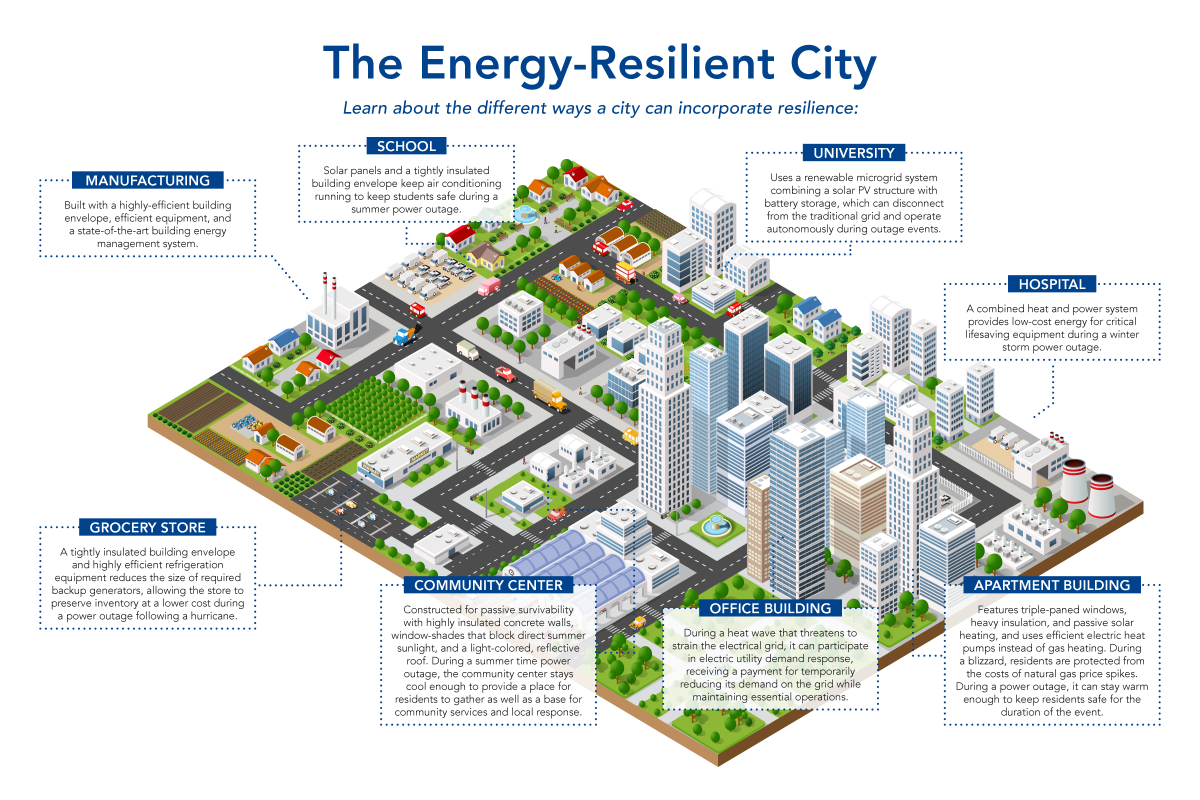
(Source: US DoE The Energy Resilient City)
Acute Need for Professionals
For the building industry, this has important implications: There is an acute need for professionals with the skills and understanding to design, operate and service grid-interactive efficient buildings (GEB). As the planet has less than a decade before negative loops of climate-change become irreversible and given the tremendous challenges in the post COVID world, there will be a great need - and job opportunities for building services engineers.
ASHRAE members need to be involved with these major changes, which will affect the industry.
Smart City - Challenges and Approach to Address Them
Communities need to have efficient energy & water management, smarter waste management, safety & security systems and transport & mobility systems, all enabled by active community participation. To do this, communities need a platform & system of systems approach to orchestrate & optimize the operation of community systems that respond to the needs of the community.
Communities are a microcosm of the larger cities that they are part of. Resilience, sustainability and quality of life are central to building a safe, healthy and vibrant community where people live, work or meet and businesses thrive. Communities need to have efficient energy and water management, smarter waste management, safety and security systems and transport and mobility systems, all enabled by active community participation. To do this, communities need a platform and system of systems approach to orchestrate and optimize the operation of community systems that respond to the needs of the community.
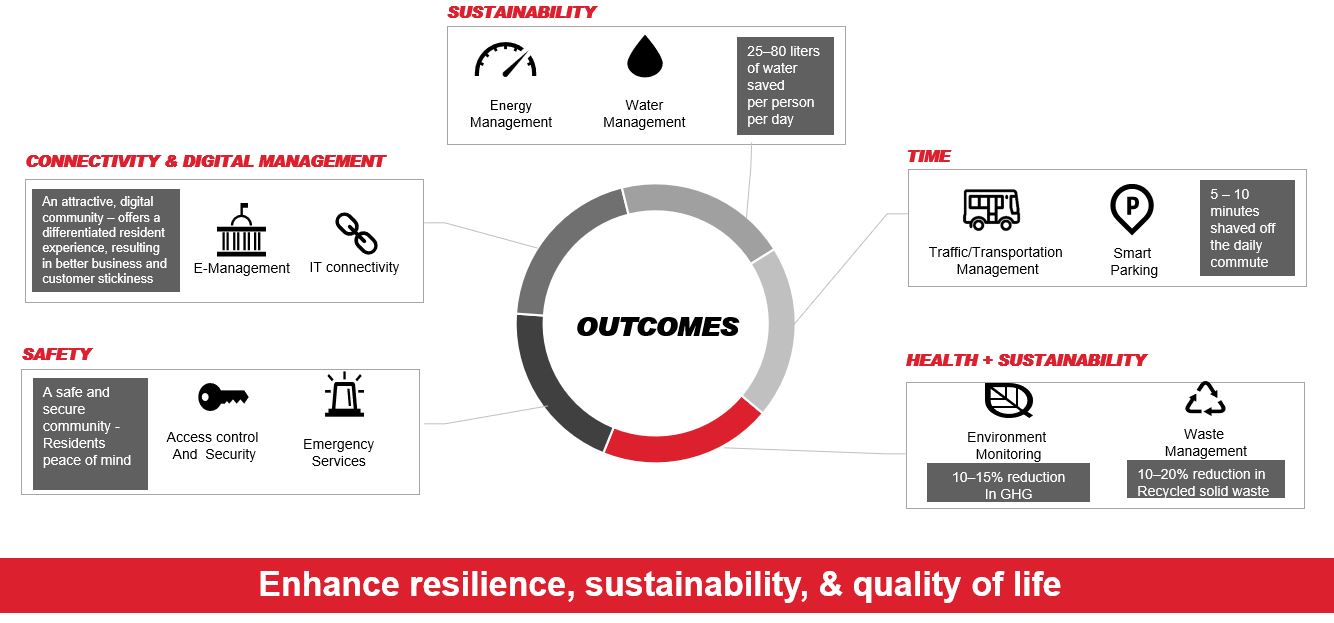 (Source: Smart cities: Digital solutions for a more livable future- McKinsey Global Institute https://www.mckinsey.com/industries/capital-projects-and-infrastructure/our-insights/smart-cities-digital-solutions-for-a-more-livable-future)
(Source: Smart cities: Digital solutions for a more livable future- McKinsey Global Institute https://www.mckinsey.com/industries/capital-projects-and-infrastructure/our-insights/smart-cities-digital-solutions-for-a-more-livable-future)
|
Smart Community Solution
A solution for smart communities should have three layers of smartness.
The “sensory layer” consists of elements such as power distribution systems, utility meters, environment sensors, waste bin sensors, street light controllers, traffic controllers, parking sensors, EV charging stations, micro mobility systems, building management systems, emergency call boxes, irrigation systems, IPTV systems, all of which connect to the community’s wired and wireless network infrastructure.
The “IOT platform” layer provides the infrastructure to integrate, aggregate and analyze data streaming from the sensor layer. The IOT platform layer consists of core services such as a IOT Hub and service bus for integration, stream processing for autonomous anomaly detection, location intelligence services, analytics services and security and identity management for cybersecurity.
The “outcomes layer” consists of specialized applications for transport management, street light management etc. to operate and manage each of the systems within the community and cross domain community management application that monitors critical parameters of all systems and orchestrates workflows and processes across multiple systems and people in the community. Together these applications provide a system of records to monitor, a system of engagement to respond and a system of intelligence to optimize the operation of systems to deliver outcomes.
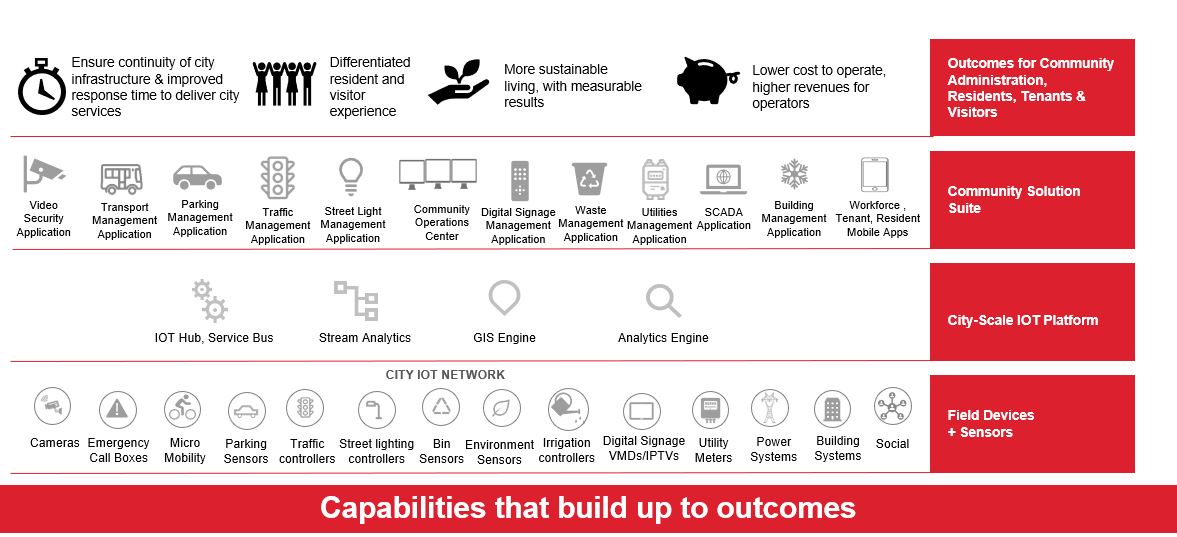
|
Hybrid Workplace
With the pandemic and current social distancing requirements, companies are rethinking whether their entire staff need to be in an office full-time. Offices will be hybrid, with many people working from home or co-working spaces, others part-time at the office. Office space will need to flexible, agile, adaptable. The norm will be hot-desking and hotelling – no fixed assigned space—with people able to take their entire office with them in their laptop. The office must support that hybrid through electronic/virtual avatars, virtual and augmented reality. Meetings will become less like Zoom and more like an in-person (but virtual) set up. Primary concerns will continue to be privacy and data security. Today, you can take your office anywhere with secure Wi-Fi and that mobility will increase. Connectedness and speed offered by 5G will be fully implemented – enabling real-time IoT sensor and controls with the ability to measure building operation, personalize comfort (tied to a badge or other token), and personal customization. These will be imbedded in digital twins where comfort, performance and productivity can be monitored. With ubiquitous renewables, DC power will become common–replacing all the transformers we use now.
Hybrid workspace will lead into reducing the distance between working from home and office. Electrical and mechanical systems will go through some level of change, what kind of expertise ASHRAE members need to develop?